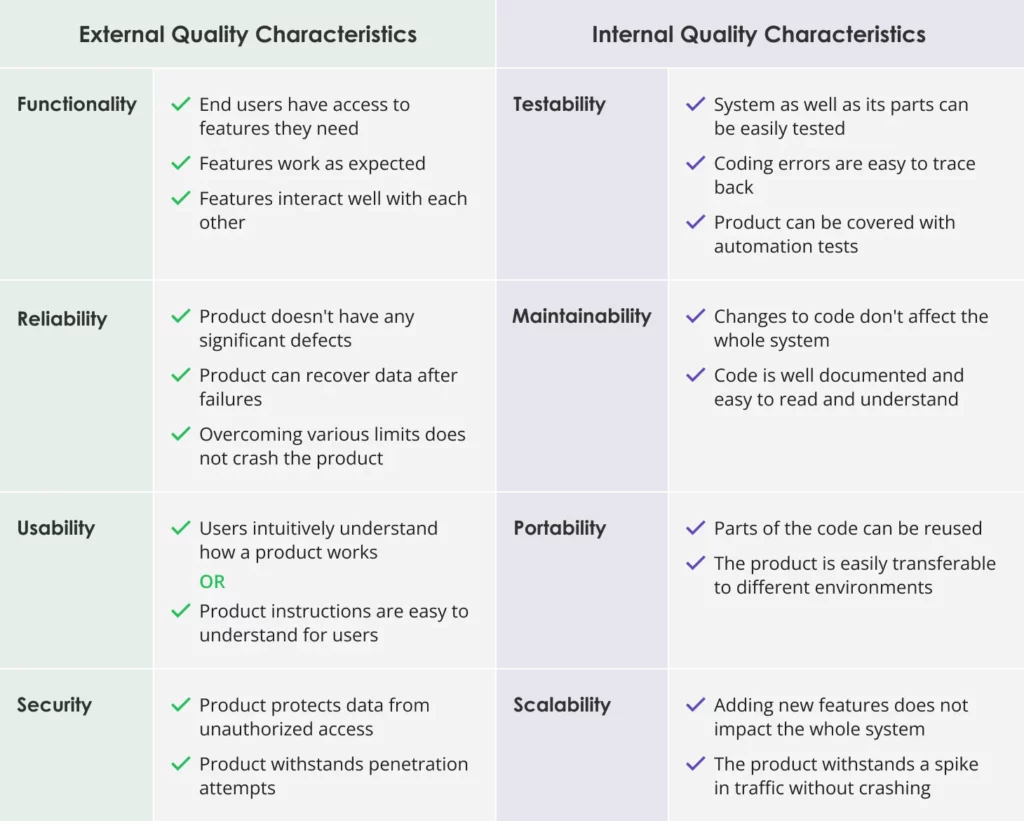Quality Assurance and Quality Control are two different approaches to achieve product excellence which are often confused and used interchangeably. QA and QC are similar in many ways, not just that they share the word “quality”. However, both processes have certain underlying differences. So let’s dive into matters and take a look at:
- What does the QA process stand for?
- What’s involved in QC activities?
- What do QC and QA have in common in software development?
- How does QA differ from QC?
- How can we combine the two processes in the SDLC?
Two Approaches to Software Quality Assurance: What Do They Encompass?
Quality Assurance (QA) and Quality Control (QC) are both parts of the software quality management process. Thus, they serve to ensure the end product corresponds to the defined standards and needs.
Both quality assurance and quality control aim to achieve two types of software quality characteristics:
- External characteristics, directly impacting how users interact with the product — functionality, reliability, usability, security, accessibility, etc.
- Internal characteristics, impacting how developers work on the product — testability, maintainability, supportability, etc.

Both QA and QC activities have a vast impact on all of the above characteristics. But QA ensures software quality by enhancing processes, and QC — by improving a product.
Let’s take a closer look at each approach to understanding their benefits.
What Is Quality Assurance?
Software Quality Assurance (SQA, or QA) is a part of quality management focused on providing confidence that quality requirements will be fulfilled.
ISTQB (International Software Testing Qualifications Board)
Encompassing the whole Software Development Life Cycle (SDLC), from the product specifications to the release and maintenance, QA’s primary goal is to ensure the continuous improvement of development processes. The end goal is to develop products that meet specifications and customer expectations.
In short, proper quality management processes should accomplish the following:
- Identify weak points in the SDLC processes
- Correct those weak points
- Improve the underlying processes
Quality Assurance is an essential part of software development. It helps control the software development process, making sure it is moving in the right direction. Yet, the major benefit of QA lies in its main function — prevention of product defects. In general, QA advantages are significant:
- Early identification and prevention of issues in the SDLC
- Closer collaboration between the testing, development, and managerial functions
- Enhanced product quality that results in a competitive advantage
So, does good quality assurance completely remove the need for quality control in your project? Absolutely not. Software development is uncertain and can be prone to mistakes. There are no guarantees that new system updates won’t add discrepancies to what has already been developed. And that is where QC comes in handy.
What Is Quality Control?
Software Quality Control (SQC, or QC) is a set of activities for ensuring the quality of software products. It is a process governed by QA and its main goal is to identify defects in the actual product produced, be it bugs, glitches, or differences from specifications.
Among the benefits of QC are:
- Encouraging quality consciousness
- Reducing production costs
- Minimizing complaints after the product is delivered
Quality Control vs. Quality Assurance: What Are the Differences?
Since QA and QC are tightly connected terms, let’s take a closer look at how these two concepts differ in objectives, focus, breadth, activities, and completion times.
Objectives: Prevention vs. Detection
While QA is oriented towards the prevention of defects in a product, QC focuses on its detection and fixing. Hence, the main goal of QA is to gauge what might go wrong before and during the SDLC by setting up criteria for the software product.
On the other hand, QC acts as a detection system of sorts, aimed at identifying bugs and flaws after the development is done to make sure your software product meets the specified criteria. The primary tool here is testing.
Focus: Process vs. Product
Quality Assurance is focused on planning, documenting, and executing guidelines that increase the quality of the development processes. It is necessary to undertake QA planning at the beginning of a project to outline software specifications. The outcomes of QA include dev process inspection, test plans, and tracking tools setup.
Quality Control, on the contrary, implements activities aimed at determining the level of quality of the product. While performing QC, you should be following all the standards and policies set up by the QA. QC assumes usage of the different types of testing (unit, integration, vulnerability testing, etc), reliance on testing metrics, and reports. The techniques of quality measurement should be agreed upon before the project starts since some of the tests and testing metrics are applied to improve the efficiency of the entire SDLC process and not the final product.
Breadth: Full SDLC vs. Testing Phase
Quality Assurance serves as a preventive technique and a proactive measure to ensure the quality of the product. Quality Control, conversely, is a corrective technique and a reactive measure. QC is usually limited to the Review/Testing phase in SDLC, whereas QA can be continuous and performed along with development in CI/CD.
Involvement: Whole Team vs. Testing Team
One of the key differences between QA and QC lies in the division of responsibilities. QA is often a shared responsibility between all development team members. QC, instead, is mostly executed by a testing team whose primary role is to test the completed software to identify defects. QC is an essential part of any product development as it helps fine-tune the final deliverable.
Activities: Processes vs. Procedures
As previously mentioned, QA is process-oriented, focusing on preventing quality issues. It entails processes such as:
- Documentation
- Process definition and implementation
- Audits
- Team training
- Change control
QC is focused on the final product. To ensure quality, QC encompasses specific procedures, among which are:
- Quality metrics
- Batch reviews
- Validation testing
Completion: Throughout The Process vs. Before the Release
The Quality Assurance team is responsible for defining the processes, establishing standards, developing checklists, etc. that need to be followed throughout the whole software development lifecycle. Quality Control is, in turn, the process to verify that deliverables comply with the functional requirements. This is usually done during the testing phase.
Quality Assurance vs Quality Control: Quick Summary
| Criteria | Quality Assurance | Quality Control |
| Objectives | Prevent defects by establishing and evaluating software engineering processes | Detect and fix defects in the actual products produced |
| Focus | Process | Product |
| Breadth | Full software development life cycle | Software testing phase |
| Involvement | Whole development team | Testing team |
| Activities | Documentation Process definition and implementation Audits Team training Change control | Quality metrics Batch reviews Product sampling Validation testing Laboratory testing |
| Completion | Throughout the process | Performed only after QA activity is done (usually before the release) |
Despite having many distinctions, QA and QC do not compete for the title of the best process to ensure the quality of the product. Instead, they complement each other by focusing on different sides of software development. Based on our experience, they work best when they are combined.
When the product development process lacks either quality assurance or quality control, you may experience the following challenges:
- Accumulation of unexpected defects because of missing quality standards
- Since there’s no one to notice and address existing errors, they require developers’ involvement and make project timelines longer
- As major bugs consume a sprint’s time, planning becomes more demanding
- Further, certain error-prone parts of the project may need to be entirely redeveloped
Without QA and QC practices in sync, you risk launching a glitching product that attracts negative reviews, damages your brand reputation, and undermines customer loyalty.
Consider car manufacturing. Without quality assurance, there would be no one to set standards for manufacturing. Crash tests would be overrun by poor-quality cars, and so quality control would take forever. Without a strong QC process, you put end-users at risk of discovering critical effects on the road.
Be the same way with your software users – build your product to initially meet quality standards, test it before you release it, and maintain a good alignment between these processes.
QA and QC: How to Align The Two Processes
Very often, companies fall into the trap of thinking they have both QA and QC in place. What they actually have is just Quality Control and software testing. They lack some significant aspects in their QA process such as compliance with quality management standards, test data adequacy, and knowledge transfer management.
Quality Assurance should come first, and be integrated into the development lifecycle from the initial stages, making sure the right processes are in place, and further testing will be done right. Quality Control should come into play once the product is complete (or when it’s already on the market) to ensure that it works as expected.
Summing Up
Quality Assurance covers the whole project starting from the planning stage. Later on, it aims at preventing recurrences of the issues found by QC by improving processes. The role of Quality Control, on the other hand, is to inspect the product to ensure that it is working as expected and to find defects. Quality Assurance doesn’t eliminate the need for Quality Control and vice versa.
At Edvantis, we know how to build these two processes to work hand in hand and ensure the quality of your software project. Contact us to learn more about setting up the QA/QC process!

